Advances in Enrichment and Purification Technology of Ammonium Perrhenate
Abstract
:1. Introduction
2. Enrichment Methods of Ammonium Perrhenate
2.1. Extraction
2.2. Ion Exchange
2.3. Chemical Precipitation
2.4. Adsorption
3. Purification Methods of Ammonium Perrhenate
3.1. Extraction
3.2. Ion Exchange
3.3. Extractive Chromatography
3.4. Recrystallization
4. Conclusions
- (1)
- In the enrichment and purification of ammonium perrhenate, chemical precipitation and adsorption methods, due to their limited regeneration capacity and selectivity, introduce additional impurity elements during the purification process. These methods are commonly employed in the enrichment of ammonium perrhenate. Consequently, enhancing the selective precipitation of rhenium to obtain higher-grade rhenium-rich slag and developing low-cost adsorbent materials with strong specific adsorption of rhenium will be the primary focus of future research on precipitation and adsorption techniques.
- (2)
- Extraction and ion exchange methods demonstrate superior efficacy for the separation and purification of ammonium perrhenate. In addition to their application in rhenium enrichment, these methods are frequently employed in rhenium purification. However, the extraction process is susceptible to emulsification due to the complex composition of impurities, while ion exchange resins exhibit limited adsorption capacity and poor selectivity for specific ions. Consequently, future research directions for extraction and ion exchange methods may focus on enhancing extractant properties, improving extraction efficiency, and developing resins with higher saturation adsorption capacity.
- (3)
- Extractive chromatography possesses the advantages of both extraction and ion exchange, demonstrating significant potential for the purification of ammonium perrhenate; however, the complex impurity composition of ammonium perrhenate presents a considerable challenge in the selection and preparation of specific resins for various ammonium perrhenates. Recrystallization can enhance the purity of ammonium perrhenate; nevertheless, its efficacy as a standalone method is limited. Future research endeavours may explore the synergistic combination of extraction chromatography and recrystallization techniques applied to the purification and preparation of high-purity ammonium perrhenate, potentially yielding a more efficient process for obtaining high-purity ammonium perrhenate.
Author Contributions
Funding
Data Availability Statement
Conflicts of Interest
References
- Liu, E.Z.; Guan, X.R.; Zheng, Z. Effect of rhenium on solidification and segregation of nickel-based superalloy. Rare Met. 2011, 30, 320–322. [Google Scholar] [CrossRef]
- Giamei, A.F.; Anton, D.L. Rhenium additions to a Ni-base superalloy: Effects on microstructure. Metall. Trans. A 1985, 16, 1997–2005. [Google Scholar] [CrossRef]
- Zhang, J.; Huang, T.; Lu, F.; Cao, K.L.; Wang, D.; Zhang, J.; Zhang, J.; Su, H.J.; Liu, L. The effect of rhenium on the microstructure stability and γ/γ′ interfacial characteristics of Ni-based single crystal superalloys during long-term aging. J. Alloys Compd. 2021, 876, 160114. [Google Scholar]
- Hu, H.; Yu, S.; Wang, T.; Lian, H.; Lv, C. Recovery of rhenium, a strategic metal, from copper smelting effluent. Sep. Purif. Technol. 2024, 337, 126403. [Google Scholar] [CrossRef]
- Papagiannopoulou, D. Technetium-99m radiochemistry for pharmaceutical applications. J. Label. Compd. Radiopharm. 2017, 60, 502–520. [Google Scholar] [CrossRef]
- Hu, T.; Hao, W.; Zou, H.; Xue, W.J.; Mei, D.H.; Song, Y.H.; Yan, W.F. Highly selective removal of Technetium-99 using imidazolium-based macroporous anion exchange resins. Chem. Eng. J. 2023, 465, 142951. [Google Scholar]
- Feruza, B.; Abdurassul, Z.; Alma, T.; Alimgazy, S.; Akmaral, S. Extraction of rhenium and osmium from lead technogenic raw materials of copper production. Materials 2022, 15, 4071. [Google Scholar] [CrossRef]
- Zhu, G.; Jiang, L.; Duan, N.; Liu, Y.; Zhang, R.; Sun, X.L.; Jin, H. The sulfurization precipitation and competition mechanisms of Cu(II) and As(V) in electrolyte towards efficient recovery of copper. J. Clean. Prod. 2024, 473, 143526. [Google Scholar]
- Barakan, S.; Aghazadeh, V. Rhenium extraction from pressure oxidative leaching solution of molybdenite concentrate using hydrophobic deep eutectic solvents. J. Mol. Liq. 2023, 376, 121481. [Google Scholar]
- Entezari, A.; Karamoozian, M.; Eskandari Nasab, M. Investigation on selective rhenium leaching from molybdenite roasting flue dusts. J. Min. Environ. 2013, 4, 77–82. [Google Scholar]
- Entezari-Zarandi, A.; Azizi, D.; Nikolaychuk, P.A.; Larachi, F.; Pasquier, L.C. Selective recovery of molybdenum over rhenium from molybdenite flue dust leaching solution using PC88A extractant. Metals 2020, 10, 1423. [Google Scholar] [CrossRef]
- Wang, Y.; Wang, C.Y. Recent advances of rhenium separation and enrichment in China: Industrial processes and laboratory trials. Chin. Chem. Lett. 2018, 29, 345–352. [Google Scholar] [CrossRef]
- Nikolaychuk, P.A. The potential-pH diagram for rhenium. Chem. Thermodyn. Therm. Anal. 2022, 7, 100068. [Google Scholar] [CrossRef]
- De, A.K.; Khopkar, S.M.; Chalmers, R.A. Solvent Extraction of Metals; Van Nostrand Reinhold: London, UK, 1970. [Google Scholar]
- Coleman, C.F.; Brown, K.B.; Moore, J.G.; Crouse, D.J. Solvent extraction with alkyl amines. Ind. Eng. Chem. 1958, 50, 1756–1762. [Google Scholar] [CrossRef]
- Roberto, D.P.; Chiarizia, R.; Coleman, C.F. The kinetics of metal solvent extraction. C R C Crit. Rev. Anal. Chem. 1980, 10, 1–126. [Google Scholar] [CrossRef]
- Salehi, H.; Tavakoli, H.; Aboutalebi, M.R.; Samim, H.R. Recovery of molybdenum and rhenium in scrub liquors of fumes and dusts from roasting molybdenite concentrates. Hydrometallurgy 2019, 185, 142–148. [Google Scholar] [CrossRef]
- Cao, Z.F.; Zhong, H.; Qiu, Z.H. Solvent extraction of rhenium from molybdenum in alkaline solution. Hydrometallurgy 2009, 97, 153–157. [Google Scholar]
- Hong, T.; Liu, M.; Ma, J.; Yang, G.; Li, L.B.; Mumford, K.A.; Stevens, G.W. Selective recovery of rhenium from industrial leach solutions by synergistic solvent extraction. Sep. Purif. Technol. 2020, 236, 116281. [Google Scholar] [CrossRef]
- Zou, Z.Q.; Zhou, Q.J. Recovery of Molybdenum and rhenium from molybdenite concentratein dexing copper ore by lime roasting-Ns extraction method. Min. Metall. Eng. 2002, 22, 79–81. [Google Scholar]
- Wang, H.D.; Wang, S.R.; Gan, M.; Fan, X.H.; Deng, Q.; Guo, H. Selective extraction Re by N235 in eluent of flue gas. Chin. J. Nonferrous Met. 2017, 27, 1302–1309. [Google Scholar]
- Levan, M.D.; Carta, G.; Yon, C.M. Adsorption and ion exchange. Energy 1997, 16, 17. [Google Scholar]
- Kumar, S.; Jain, S. History, introduction, and kinetics of ion exchange materials. J. Chem. 2013, 2013, 957647. [Google Scholar] [CrossRef]
- Dudek, S.; Kołodyńska, D. Arsenate removal on the iron oxide ion exchanger modified with neodymium (III) ions. J. Environ. Manag. 2022, 307, 114551. [Google Scholar]
- Wu, X.M.; Shu, Z.N. Adsorption of rhenium (VII) with D301 resin. Chin. J. Inorg. Chem. 2009, 25, 1227–1232. [Google Scholar]
- Jiang, X.H.; Lou, M.B.; Hua, R.; Li, H.N.; Jiang, Q.F.; Wang, Y.C.; Tang, R.J.; Xu, B.; Guo, R.H.; Su, X.B.; et al. Application and Characteristics of Adsorption Rhenium with D302-II Resin. Chin. J. Rare Met. 2012, 36, 610–616. [Google Scholar]
- Zang, X.L.; Li, W.; Ning, R.; An, L.C. Experimental study of rhenium recovery by adsorbed it from thewaste acid using D990 ion exchange. China Nonferrous Metall. 2017, 1, 65–67. [Google Scholar]
- Chen, K.K.; Meng, H.Q.; Wu, Y.Q.; Zhang, B.S.; Cao, Q.G. Study on preparation of perrhenic acid. Nonferrous Met. Extr. Metall. 2017, 7, 44–47. [Google Scholar]
- Wang, S.L.; Guo, X.Y.; Shi, X.S.; Hou, M.W. A Method of Extracting Rhenium from Fouling Acid in Copper Refining; Zhengzhou Datong Patent and Trademark Agency Co., Ltd.: Zhengzhou, China, 2018. [Google Scholar]
- Zhang, B.; Liu, H.Z.; Wang, W.; Gao, Z.G.; Cao, Y.H. Recovery of rhenium from copper leach solutions using ion exchange with weak base resins. Hydrometallurgy 2017, 173, 50–56. [Google Scholar]
- Zu, J.H.; Ye, M.S.; Wang, P.Y.; Tang, F.D.; He, L.F. Design of a strong-base anion exchanger and its adsorption and elution behavior of rhenium (VII). RSC Adv. 2016, 6, 18868–18873. [Google Scholar]
- Dong, Z.; Wen, D.; Zhang, M.M.; Xie, K.J.; Hua, R.; Zhao, L. Recovery of rhenium (VII) from synthetic leaching solutions of uranium ore using ionic liquid modified cellulose microsphere adsorbents. Hydrometallurgy 2020, 197, 105457. [Google Scholar] [CrossRef]
- Nebeker, N.; Hiskey, J.B. Recovery of rhenium from copper leach solution by ion exchange. Hydrometallurgy 2012, 125, 64–68. [Google Scholar]
- Shih, Y.J.; Chien, S.K.; Jhang, S.R.; Lin, Y.C. Chemical leaching, precipitation and solvent extraction for sequential separation of valuable metals in cathode material of spent lithium ion batteries. J. Taiwan Inst. Chem. Eng. 2019, 100, 151–159. [Google Scholar]
- Zhang, Y.H.; Feng, X.Y.; Jin, B.J. An effective separation process of arsenic, lead, and zinc from high arsenic-containing copper smelting ashes by alkali leaching followed by sulfide precipitation. Waste Manag. Res. 2020, 38, 1214–1221. [Google Scholar] [PubMed]
- Li, D.; Chang, J.; Wei, Y.X.; Qiao, J.X.; Yue, X.L.; Fan, H.J.; Zhang, L.; Guo, X.Y. Green and efficient recovery of tungsten from spent SCR denitration catalyst by Na2S alkali leaching and calcium precipitation. Adv. Sustain. Syst. 2025, 2400895. [Google Scholar]
- Estay, H.; Barros, L.; Troncoso, E. Metal sulfide precipitation: Recent breakthroughs and future outlooks. Minerals 2021, 11, 1385. [Google Scholar] [CrossRef]
- Shi, Q.T.; Zhang, S.J.; Ge, J.; Wei, J.S.; Christodoulatos, C.; Korfiatis, G.P.; Meng, X.G. Lead immobilization by phosphate in the presence of iron oxides: Adsorption versus precipitation. Water Res. 2020, 179, 115853. [Google Scholar]
- Liu, X.H.; Zhong, M.L.; Chen, X.Y.; Zhao, Z.W. Separating lithium and magnesium in brine by aluminum-based materials. Hydrometallurgy 2018, 176, 73–76. [Google Scholar]
- Abisheva, Z.S.; Zagorodnyaya, A.N.; Bekturganov, N.S. Review of technologies for rhenium recovery from mineral raw materials in Kazakhstan. Hydrometallurgy 2011, 109, 1–8. [Google Scholar]
- Wang, Y.B.; Huang, J.F.; Li, W.; Liang, F.M. An experimental study of the enrichment of rhenium from copper smeltingwaste acid by the sodium thiosulfate precipitation method. Acta Petrol. Mineral. 2015, 34, 110–116. [Google Scholar]
- Hong, T.; Zheng, T.; Liu, M.B.; Mumford, K.A.; Stevens, G.W. Investigation on the recovery of rhenium in the high arsenite wash acid solution from the copper smelting process using reducing sulfide precipitation method. Hydrometallurgy 2020, 195, 105402. [Google Scholar]
- Lu, X.W.; Li, S.R.; Zhang, E.Y.; Cheng, L.; Li, Y.L.; Niu, Y.S. Study on enrichment technology of rhenium in wasteacid from copper smelting. Nonferrous Met. Extr. Metall. 2020, 4, 47–50. [Google Scholar]
- Li, J. Separation of copper and rhenium from copper smelting waste acid by chemical precipitation. Hydrometall. China 2016, 35, 440–443. [Google Scholar]
- Zhang, H.R.; Zhong, S.P.; Liu, X.Y.; Wang, J.E. Study on potassium perrhenate preparation by rhenium extraction from copper smelting waste-acid. China Acad. J. Electron. Publ. House 2018, 1, 1–65. [Google Scholar]
- Hori, H.; Yonezato, Y.; Ito, K. Recovery of platinum and rhenium using selective precipitation induced by two-stage photochemical treatment. Hydrometallurgy 2022, 211, 105883. [Google Scholar] [CrossRef]
- Gupta, S.S.; Bhattacharyya, K.G. Kinetics of adsorption of metal ions on inorganic materials: A review. Adv. Colloid Interface Sci. 2011, 162, 39–58. [Google Scholar]
- Wang, L.; Song, H.; Yuan, L.Y.; Li, Z.J.; Zhang, P.; Gibson, J.K.; Zheng, L.R.; Wang, H.Q.; Chai, Z.F.; Shi, W.Q. Effective removal of anionic Re (VII) by surface-modified Ti2CTx MXene nanocomposites: Implications for Tc (VII) sequestration. Environ. Sci. Technol. 2019, 53, 3739–3741. [Google Scholar] [CrossRef]
- Zhang, L.; Jiang, X.Q.; Xu, T.C.; Yang, L.J.; Zhang, Y.Y.; Jin, H.J. Sorption characteristics and separation of rhenium ions from aqueous solutions using modified nano-Al2O3. Ind. Eng. Chem. Res. 2012, 51, 5577–5584. [Google Scholar] [CrossRef]
- Li, Y.H.; Wang, Q.; Li, Q.; Zhang, Z.Z.; Zhang, L.; Liu, X.Y. Simultaneous speciation of inorganic rhenium and molybdenum in the industrial wastewater by aminofunctionalized nano-SiO2. J. Taiwan Inst. Chem. Eng. 2015, 55, 126–132. [Google Scholar]
- Shan, W.J.; Wang, D.D.; Zhang, Z.T.; Lou, Z.N.; Xiong, Y.; Fan, Y. Synthesis of Schiff base-functionalized silica for effective adsorption of Re (VII) from aqueous solution. J. Taiwan Inst. Chem. Eng. 2019, 100, 277–284. [Google Scholar]
- Alfaro, I.; Molina, L.; González, P.; Gaete, J.; Valenzuela, F.; Marco, J.F.; Sáez, C.; Basualto, C. Silica-coated magnetite nanoparticles functionalized with betaine and their use as an adsorbent for Mo (VI) and Re (VII) species from acidic aqueous solutions. J. Ind. Eng. Chem. 2019, 78, 271–283. [Google Scholar]
- Ho, Y.S.; McKay, G. A comparison of chemisorption kinetic models applied to pollutant removal on various sorbents. Process Saf. Environ. Prot. 1998, 76, 332–340. [Google Scholar] [CrossRef]
- Wu, F.C.; Tseng, R.L.; Juang, R.S. Characteristics of Elovich equation used for the analysis of adsorption kinetics in dye-chitosan systems. Chem. Eng. J. 2009, 150, 366–373. [Google Scholar] [CrossRef]
- Seo, S.Y.; Choi, W.S.; Yang, T.J.; Kim, M.J.; Tran, T. Recovery of rhenium and molybdenum from a roaster fume scrubbing liquor by adsorption using activated carbon. Hydrometallurgy 2012, 129, 145–150. [Google Scholar] [CrossRef]
- Kołczyk, S.K.; Socha, R.P.; Yang, X.G.; Eckert, K.; Wojnicki, M. Study on kinetics and mechanism of Re (VII) ion adsorption and desorption using commercially available activated carbon and solutions containing Se (VI) as an impurity. Hydrometallurgy 2023, 215, 105973. [Google Scholar] [CrossRef]
- Hu, H.; Sun, L.; Jiang, B.; Wu, H.X.; Huang, Q.M.; Chen, X.H. Low concentration Re (VII) recovery from acidic solution by Cu-biochar composite prepared from bamboo (Acidosasa longiligula) shoot shell. Miner. Eng. 2018, 124, 123–136. [Google Scholar] [CrossRef]
- Xiong, Y.; Cui, X.; Zhang, P.; Wang, Y.J.; Lou, Z.N.; Shan, W.J. Improving Re (VII) adsorption on diisobutylamine-functionalized graphene oxide. ACS Sustain. Chem. Eng. 2017, 5, 1010–1018. [Google Scholar] [CrossRef]
- Li, H.S.; Lin, M.; Xiao, T.F.; Long, J.Y.; Liu, F.L.; Li, Y.T.; Liu, Y.; Liao, D.D.; Chen, Z.X.; Zhang, P.; et al. Highly efficient removal of thallium (I) from wastewater via hypochlorite catalytic oxidation coupled with adsorption by hydrochar coated nickel ferrite composite. J. Hazard. Mater. 2020, 388, 122016. [Google Scholar] [CrossRef]
- Shen, L.; Tesfaye, F.; Li, X.; Lindberg, D.; Taskinen, P. Review of rhenium extraction and recycling technologies from primary and secondary resources. Miner. Eng. 2021, 161, 106719. [Google Scholar] [CrossRef]
- Lou, Z.; Guo, C.; Feng, X.; Zhang, S.Q.; Xing, Z.Q.; Shan, W.J.; Xiong, Y. Selective extraction and separation of Re (VII) from Mo (VI) by TritonX-100/N235/iso-amyl alcohol/n-heptane/NaCl microemulsion system. Hydrometallurgy 2015, 157, 199–206. [Google Scholar] [CrossRef]
- Cheema, H.A.; Ilyas, S.; Masud, S.; Muhsan, M.A.; Mahmood, I.; Lee, J.C. Selective recovery of rhenium from molybdenite flue-dust leach liquor using solvent extraction with TBP. Sep. Purif. Technol. 2018, 191, 116–121. [Google Scholar] [CrossRef]
- Quijada-Maldonado, E.; Allain, A.; Pérez, B.; Merlet, G.; Cabezas, R.; Tapia, R.; Romero, J. Selective liquid-liquid extraction of molybdenum (VI) and rhenium (VII) from a synthetic pregnant leach solution: Comparison between extractants and diluents. Miner. Eng. 2020, 145, 106060. [Google Scholar]
- Shan, W.; Shu, Y.; Chen, H.; Zhang, D.Y.; Wang, W.; Ru, H.Q.; Xiong, Y. The recovery of molybdenum (VI) from rhenium (VII) on amino-functionalized mesoporous materials. Hydrometallurgy 2016, 165, 251–260. [Google Scholar]
- Fang, D.W.; Song, Z.R.; Zhou, Z.K.; Shan, W.J.; Li, J. Solvent extraction of rhenium in ionic liquid with N235. J. Chem. Eng. Data 2017, 62, 2423–2427. [Google Scholar]
- Fang, D.W.; Shan, W.J.; Yan, Q.; Li, D.; Xia, L.X.; Zang, S.L. Extraction of rhenium from sulphuric acid solution with used amine N235. Fluid Phase Equilibria 2014, 383, 1–4. [Google Scholar] [CrossRef]
- Lou, Z.N.; Xiong, Y.; Song, J.J.; Shan, W.J.; Han, G.X.; Xing, Z.Q.; Kong, Y.X. Kinetics and mechanism of Re (VII) extraction and separation from Mo (VI) with trialkyl amine. Trans. Nonferrous Met. Soc. China 2010, 20, s10–s14. [Google Scholar]
- Danesi, P.R.; Vandergrift, G.F. Kinetics and mechanism of the interfacial mass transfer of Eu3+ and Am3+ in the System bis(2-ethylhexyl) phosphate-n-dodecane-NaCl-HCl-water. J. Phys. Chem. 1981, 85, 3646–3651. [Google Scholar] [CrossRef]
- Truong, H.T.; Nguyen, T.H.; Lee, M.S. Separation of molybdenum (VI), rhenium (VII), tungsten (VI), and vanadium (V) by solvent extraction. Hydrometallurgy 2017, 171, 298–305. [Google Scholar]
- Yi, A.F.; Liu, Y.; Lu, X.W.; Chen, S.; Jiang, H.L.; Shao, C.B.; Yuan, X.T.; Yin, Y.X. New approach for thallium removal by P204 extraction and its effect on the ammonium rhenate refining. Separations 2022, 9, 221. [Google Scholar]
- Yi, A.F.; Liu, Y.; Yu, J.H.; Wang, C.Z.; Lu, X.W.; Jin, M.H.; LI, Y.L.; Shao, C.B. A Method of Purifying and Removing Potassium from Ammonium Perrhenate; Research Resources and Environmental Technology Research Institute Co., Ltd.: Beijing, China, 2022. [Google Scholar]
- Joo, S.H.; Kim, Y.U.; Kang, J.G.; Kumar, J.R.; Yoon, H.s.; Parhi, P.K.; Shin, S.M. Recovery of rhenium and molybdenum from molybdenite roasting dust leaching solution by ion exchange resins. Mater. Trans. 2012, 53, 2034–2037. [Google Scholar] [CrossRef]
- Fisher, S.A.; Meloche, V.W. Ion exchange separation of rhenium from molybdenum. Anal. Chem. 1952, 24, 1100–1106. [Google Scholar]
- Hamaguchi, H.; Kawabuchi, K.; Kuroda, R. Anion exchange separation of rhenium from molybdenum and technetium in thiocyanate-chloride media. Anal. Chem. 1964, 36, 1654–1656. [Google Scholar] [CrossRef]
- Blazy, P.; Jdid, E.A.; Floreancig, A.; Mottet, B. Selective recovery of rhenium from gas-scrubbing solutions of molybdenite roasting using direct precipitation and separation on resins. Sep. Sci. Technol. 1993, 28, 2073–2096. [Google Scholar] [CrossRef]
- Kirillov, E.; Bochkareva, Z.; Semenishchev, V.; Kirillov, S.; Bunkov, G.; Rychkov, V. Anion exchange recovery of rhenium from industrial liquors followed by direct synthesis of a rhenium halide salt. Hydrometallurgy 2024, 230, 106387. [Google Scholar] [CrossRef]
- Yu, J.; Zhang, M.; Wang, N.; Zhai, M.L.; Hua, R.; Yan, J.T.; Li, X.F.; Que, X.Y.; Zhao, L. Highly efficient recovery of Re (VII) from uranium and molybdenum ores leaching solution by quaternary phosphonium modified cellulose microspheres. J. Taiwan Inst. Chem. Eng. 2025, 168, 105937. [Google Scholar] [CrossRef]
- Anusuya, B.; Murty, V.S.; Rao, K.V.S.R. New rhenium centers in ammonium and potassium perrhenates. J. Mol. Struct. 1995, 344, 135–142. [Google Scholar] [CrossRef]
- Volkova, T.S.; Rudskikh, V.V. Mechanism and sorption parameters of alkali metal ions on strongly acidic cation exchange resins. Russ. J. Gen. Chem. 2017, 87, 506–514. [Google Scholar] [CrossRef]
- Cholsaipant, P.; George, J.L.; Kim, D.; Kruger, A.A. Volatility of sodium, potassium, and cesium perrhenates determined by thermogravimetry. J. Therm. Anal. Calorim. 2022, 147, 9291–9299. [Google Scholar] [CrossRef]
- Jadbabaei, N.; Zhang, H. Sorption mechanism and predictive models for removal of cationic organic contaminants by cation exchange resins. Environ. Sci. Technol. 2014, 48, 14572–14581. [Google Scholar] [CrossRef]
- Zagorodnyaya, A.N.; Abisheva, Z.S.; Sadykanova, S.E.; Sharipova, A.S.; Akcil, A. Purification of ammonium perrhenate solutions from potassium by ion exchange. Miner. Process. Extr. Metall. Rev. 2017, 38, 284–291. [Google Scholar] [CrossRef]
- Parizi, M.T.; Mostafavi, A.; Shamspur, T. Potassium adsorption from ammonium perrhenate solutions via ion exchange resin: Characterization and kinetic study. J. Iran. Chem. Soc. 2023, 20, 1469–1480. [Google Scholar] [CrossRef]
- Uemura, Y.; Moritake, I.; Kurihara, S.; Nonaka, T. Preparation of resins having various phosphonium groups and their adsorption and elution behavior for anionic surfactants. J. Appl. Polym. Sci. 2015, 72, 371–378. [Google Scholar]
- Matsunaga, H.; Ismail, A.A.; Wakui, Y.; Yokoyama, T. Extraction of rare earth elements with 2-ethylhexyl hydrogen 2-ethylhexyl phosphonate impregnated resins having different morphology and reagent content. React. Funct. Polym. 2001, 49, 189–195. [Google Scholar]
- Nakamura, T.; Ikawa, T.; Nishihama, S.; Yoshizuka, K. Selective recovery of indium from acid sulfate media with solvent impregnated resin of bis (4-cyclohexylcyclohexyl) phosphoric acid as an extractant. Ion Exch. Lett. 2009, 2, 22–26. [Google Scholar]
- Liao, C.F.; Jiao, Y.F.; Liang, Y.; Jiang, P.G.; Nie, H.P. Adsorption-extraction mechanism of heavy rare earth by Cyanex272-P507 impregnated resin. Trans. Nonferrous Met. Soc. China 2010, 20, 1511–1516. [Google Scholar]
- Helaly, O.S.; El-Ghany, M.S.A.; Moustafa, M.I.; Abuzaid, A.H.; El-Monem, N.M.A.; Ismail, I.M. Extraction of cerium (IV) using tributyl phosphate impregnated resin from nitric acid medium. Trans. Nonferrous Met. Soc. China 2012, 22, 206–214. [Google Scholar] [CrossRef]
- Horwitz, E.P.; Dietz, M.L.; Rhoads, S.; Felinto, C.; Gale, N.H.; Houghton, J. A lead-selective extraction chromatographic resin and its application to the isolation of lead from geological samples. Anal. Chim. Acta 1994, 292, 263–273. [Google Scholar]
- Pang, J.F.; Li, J. Extraction-macroporous resin combined technology. Technol. Water Treat. 2010, 36, 74–77. [Google Scholar]
- Gujar, R.B.; Ansari, S.A.; Mohapatra, P.K.; Egberink, R.J.M.; Huskens, J.; Verboom, W. Highly efficient extraction chromatography resin containing hexa-n-octyl nitrilotriacetamide (HONTA) for selective recovery of plutonium from acidic feeds. Ind. Eng. Chem. Res. 2023, 62, 5954–5961. [Google Scholar]
- Lučaníková, M.; Kučera, J.; Šebesta, F. New extraction chromatographic material for rhenium separation. J. Radioanal. Nucl. Chem. 2008, 277, 479–485. [Google Scholar]
- Moon, J.K.; Han, Y.J.; Jung, C.H.; Lee, E.H.; Lee, B.C. Adsorption of rhenium and rhodium in nitric acid solution by Amberlite XAD-4 impregnated with Aliquat 336. Korean J. Chem. Eng. 2006, 23, 303–308. [Google Scholar]
- Jiang, K.X.; Zhai, Y.C.; Xiong, Y.; Wang, X.F. Study on the extraction and separation of rhenium and molybdenum by levextrel resins containing trialkyl amine. Nonferrous Met. Extr. Metall. 2010, 2, 35–37. [Google Scholar]
- Liu, F.; Hua, R.; Zhang, F.; Liu, H.; Lee, C.P.; Liu, H.S.; Xu, B. Adsorption and separation of Re (VII) using trimethylamine-functionalized strong base anion exchange resin. J. Radioanal. Nucl. Chem. 2020, 326, 445–454. [Google Scholar] [CrossRef]
- Banerjee, P.; Ansari, S.A.; Mohapatra, P.K.; Egberink, R.J.M.; Huskens, J.; Valsala, T.P.; Sathe, D.B.; Bhatt, R.B.; Verboom, W. Sequestration of actinides by an extraction chromatography resin containing a triaza-9-crown-3 functionalized diglycolamide. Ind. Eng. Chem. Res. 2023, 62, 13966–13973. [Google Scholar]
- Saha, B.; Gill, R.J.; Bailey, D.G.; Kabay, N.; Arda, M. Sorption of Cr (VI) from aqueous solution by amberlite XAD-7 resin impregnated with aliquat 336. React. Funct. Polym. 2004, 60, 223–244. [Google Scholar]
- Lee, G.S.; Uchikoshi, M.; Mimura, K.; Isshiki, M. Separation of major impurities Ce, Pr, Nd, Sm, Al, Ca, Fe, and Zn from La using bis (2-ethylhexyl) phosphoric acid (D2EHPA)- impregnated resin in a hydrochloric acid medium. Sep. Purif. Technol. 2010, 71, 186–191. [Google Scholar]
- Lee, G.S.; Uchikoshi, M.; Mimura, K.; Isshiki, M. Preparation and evaluation of high-purity La2O3. Metall. Mater. Trans. B 2010, 41, 509–519. [Google Scholar] [CrossRef]
- Logé, R.E. Nanotwinning-assisted recrystallization. Nat. Mater. 2022, 21, 738–739. [Google Scholar] [CrossRef]
- Ferdinand Knipschildt, E.F. Nucleation of recrystallization. Mater. Sci. Technol. 2022, 38, 765–779. [Google Scholar]
- Tiamiyu, A.A.; Pang, E.L.; Chen, X.; Lebeau, J.M.; Nelson, K.A.; Schuh, C.A. Nanotwinning-assisted dynamic recrystallization at high strains and strain rates. Nat. Mater. 2022, 21, 786–794. [Google Scholar]
- Orda, S.; Drzazga, M.; Leszczyńska-Sejda, K.; Ciszewski, M.; Kocur, A.; Branecka, P.; Gall, K.; Słaboń, M.; Lemanowicz, M. Investigations of the density and solubility of ammonium perrhenate and potassium perrhenate aqueous solutions. Materials 2023, 16, 5481. [Google Scholar] [CrossRef]
- Brunner, J.; Maier, B.; Rosenberg, R.; Sturm, S.; Cölfen, H.; Sturm, E.V. Nonclassical recrystallization. Chem. A Eur. J. 2020, 26, 15242–15248. [Google Scholar]
- Liu, H.J.; Li, R.D.; Zhou, X.; Wang, Y.; Zhu, L.; Tong, P.Y. A Preparation Method of High Purity Rhenium Powder. Pilot Film Materials (Guangdong) Co., Ltd.: Qingyuan, China, 2024. [Google Scholar]
- Tang, J.J.; Feng, L.; Zhang, C.W.; Sun, Y.; Wang, L.; Zhou, Y.Z.; Fang, D.W.; Liu, Y. The influences of stirring on the recrystallization of ammonium perrhenate. Appl. Sci. 2020, 10, 656. [Google Scholar] [CrossRef]
- Fan, J.Y.; Zhang, H.Y.; Tang, J.J.; Pei, X.Y.; Cao, N.; Liu, Y. Research and process of 4 N grade high purity ammonium rhenate prepared by homogeneous recrystallization. Mod. Chem. Res. 2023, 18, 1–4. [Google Scholar]
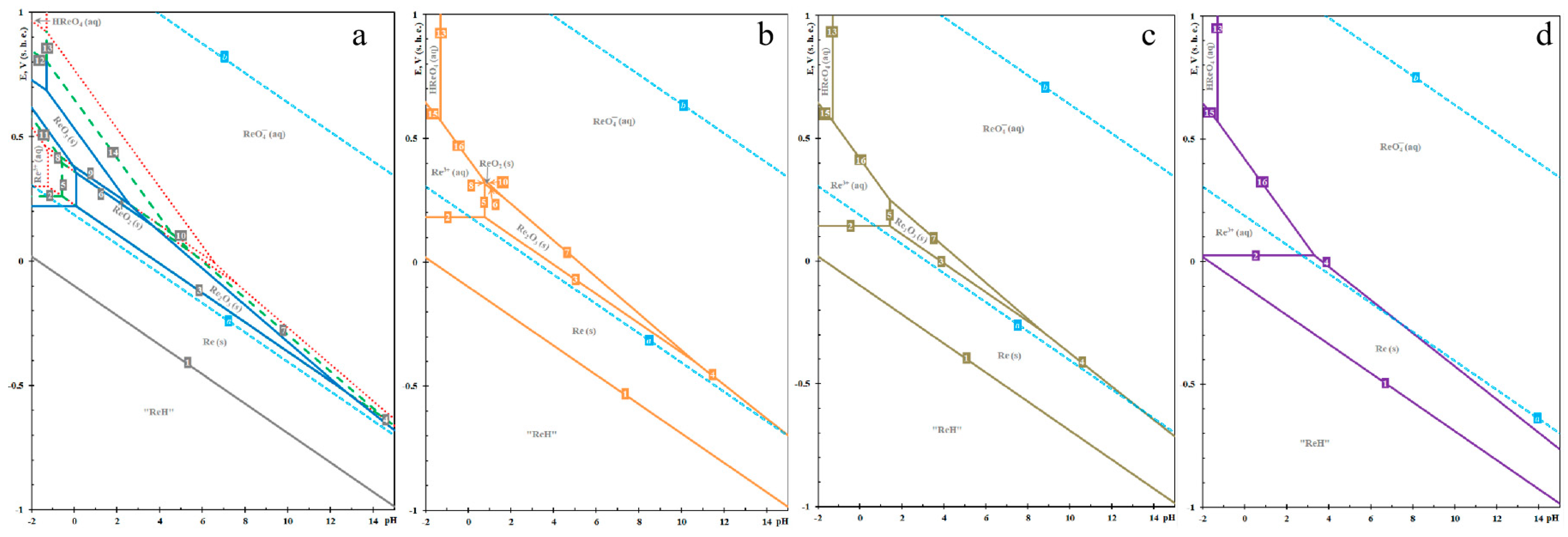
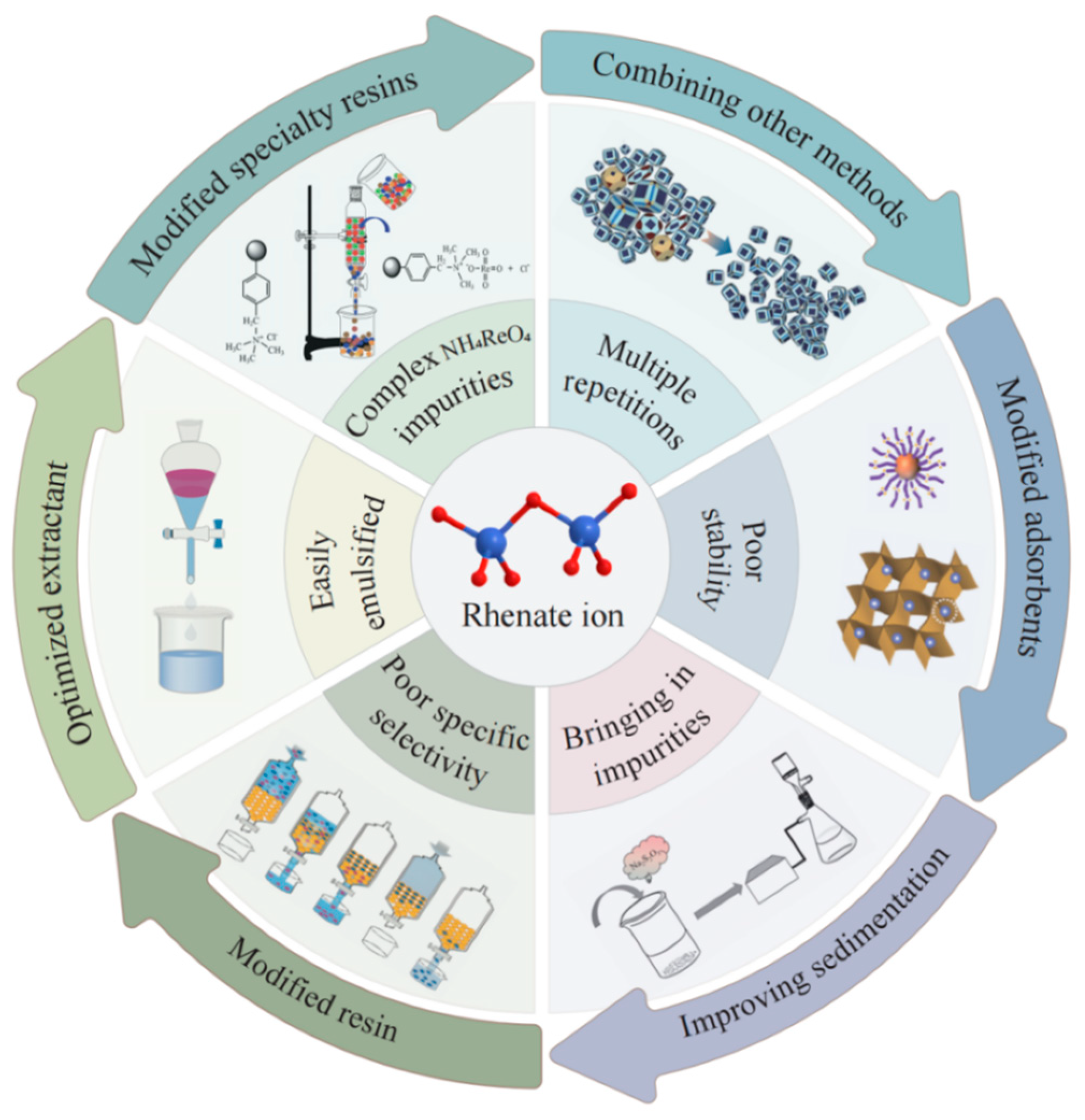


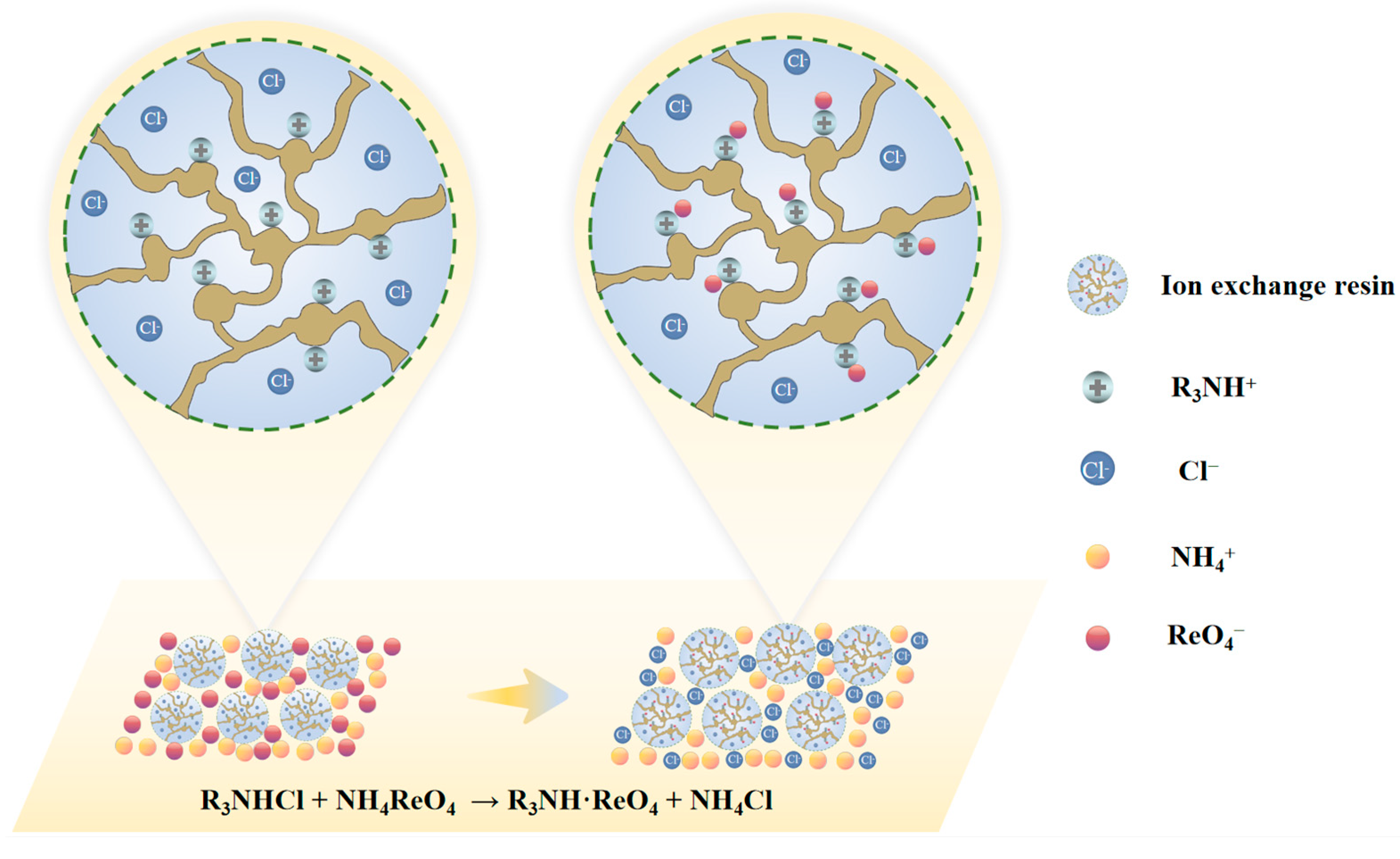
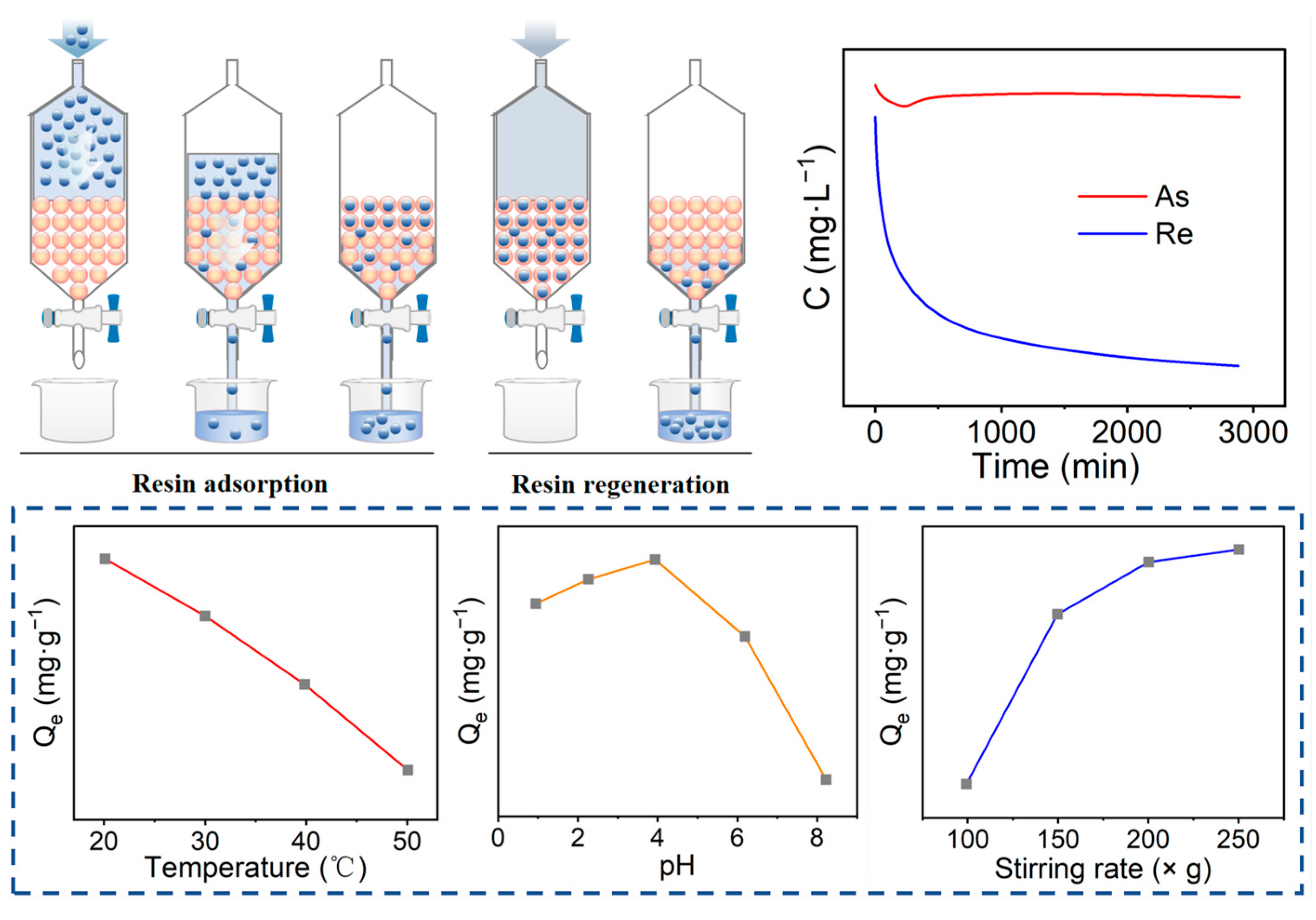

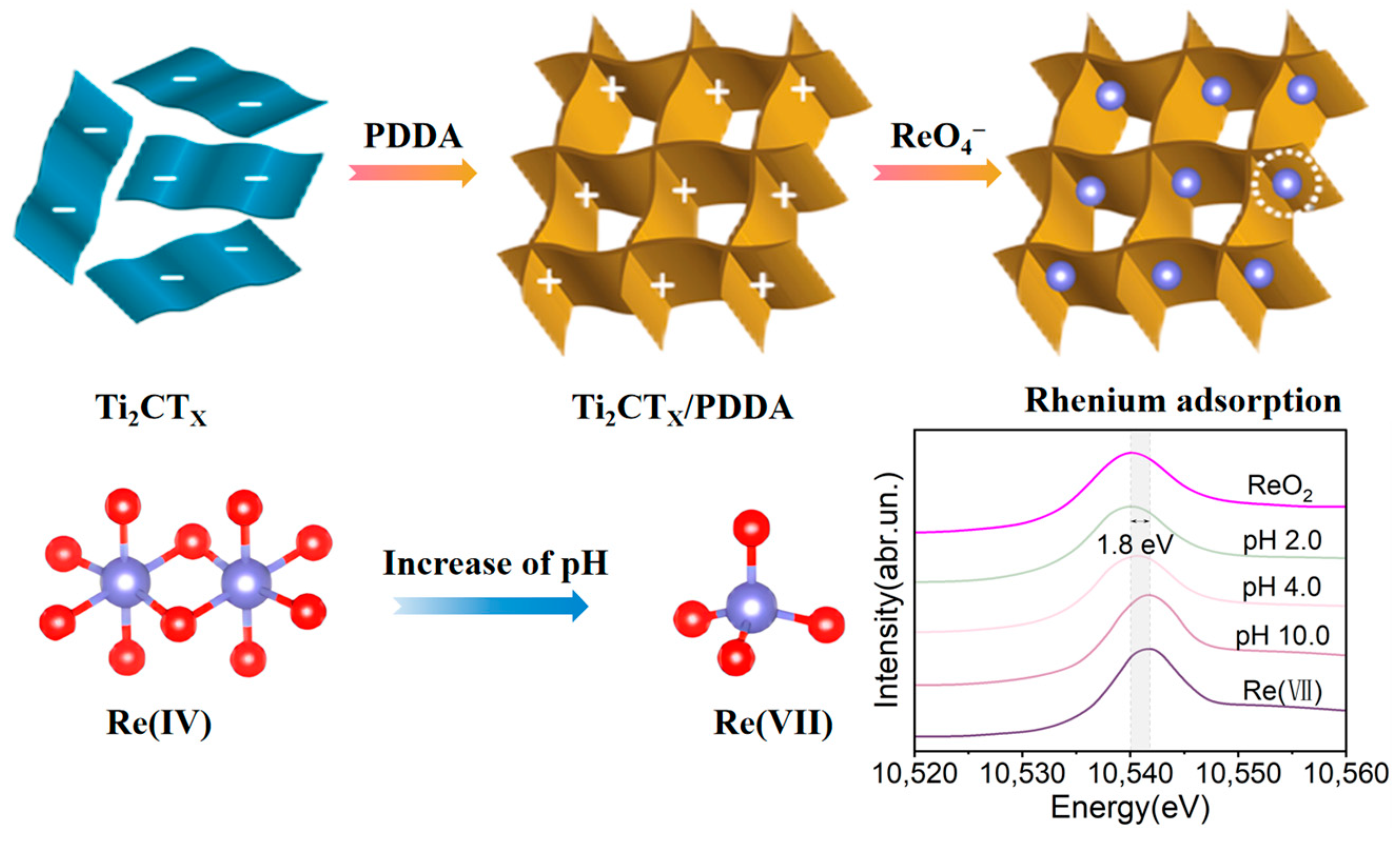
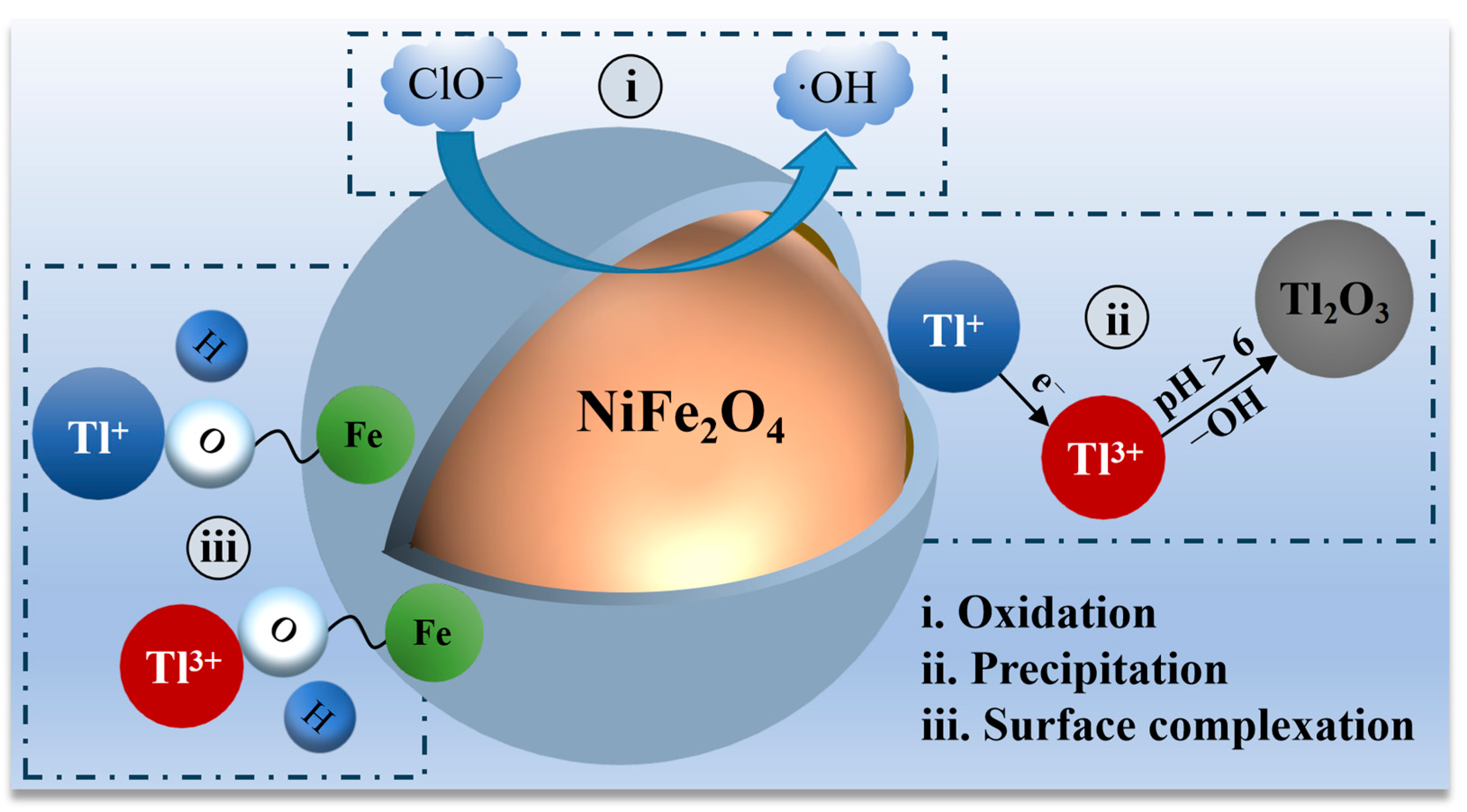
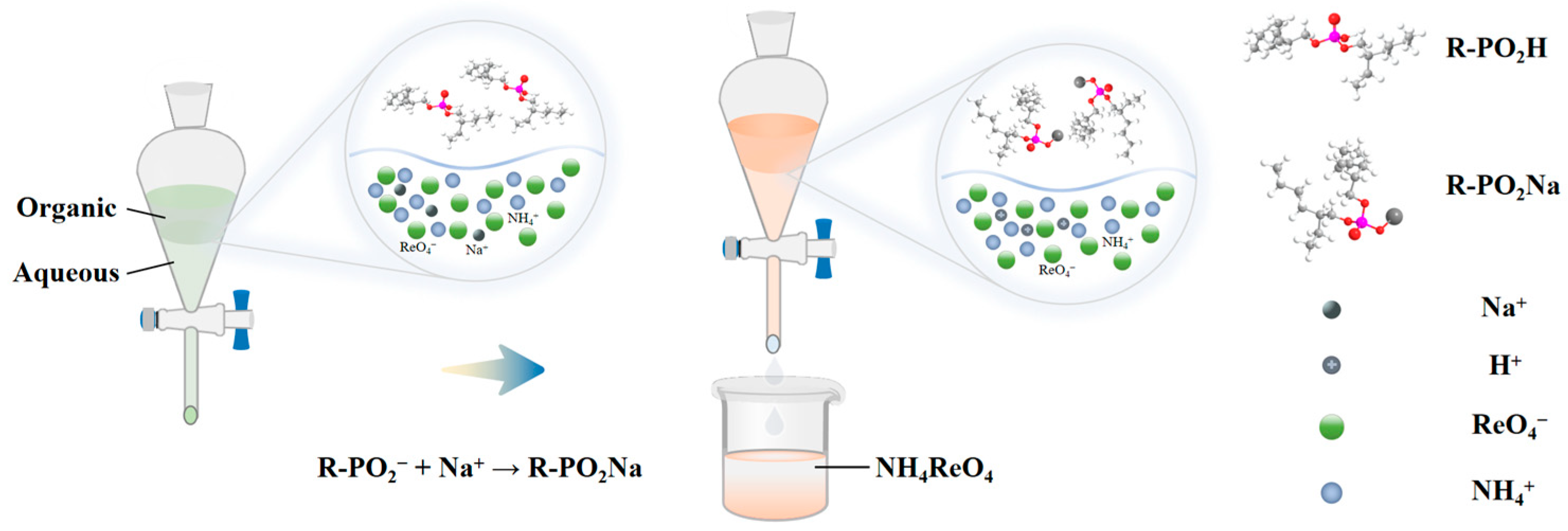
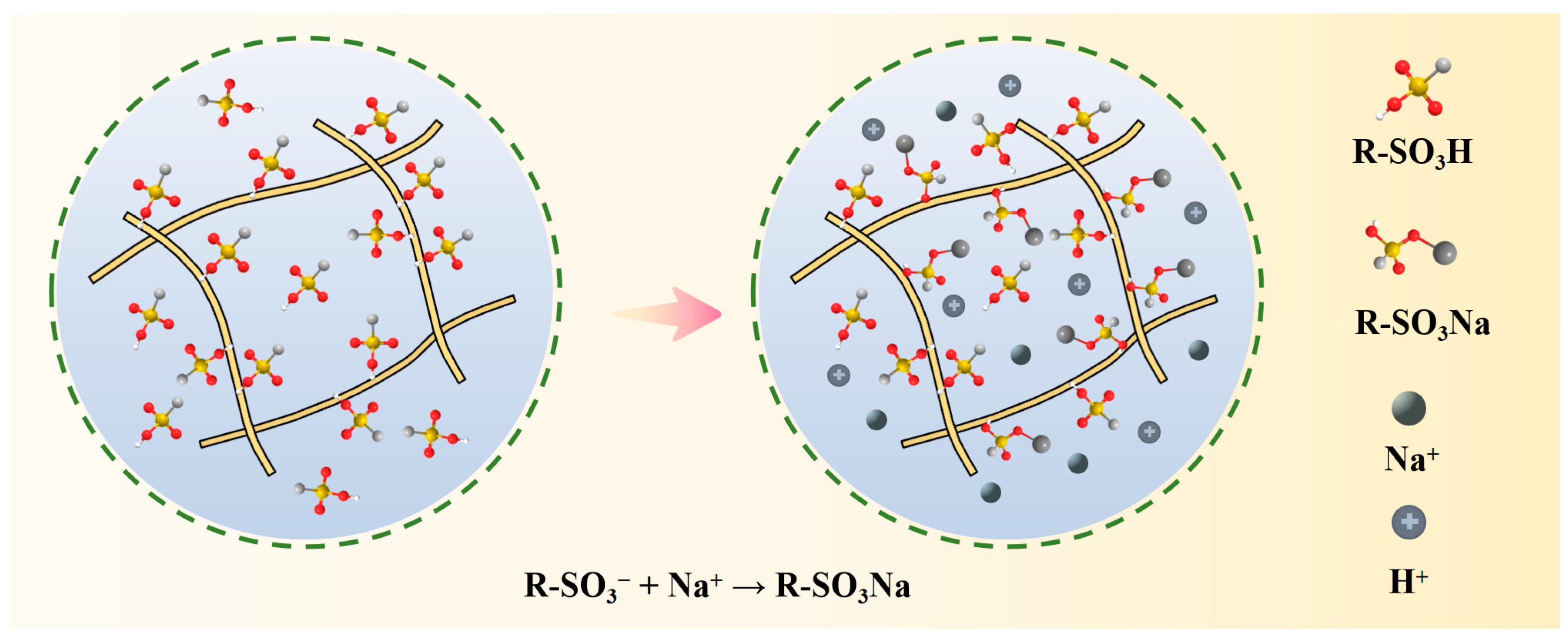

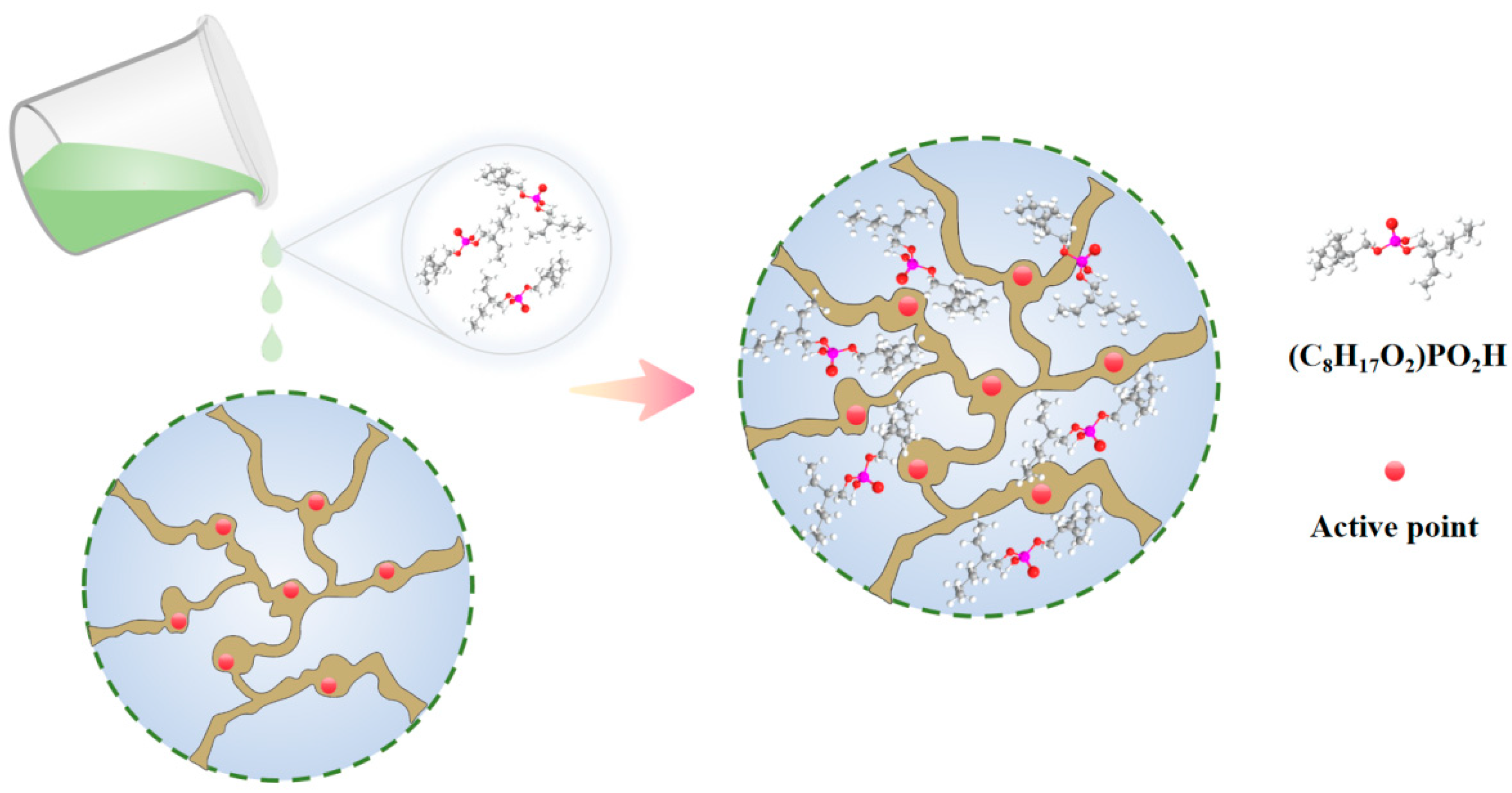
| Extraction System | Solution Conditions | Extraction Efficiency | Back-Extracting Solution | References |
|---|---|---|---|---|
| TBP, D2EHPA | pH 6.5–7 | 99.6% | 32 vol% NH3·H2O | [17] |
| 20 vol% N235, 30 vol% TBP, 50 vol% kerosene | pH 9 | 96.8% | 18 vol% NH3·H2O | [18] |
| Alamine 336, TBP | H2SO4 | 98.78% | 4 mol·L−1 NH3·H2O | [19] |
| 30 vol% N235–40 vol% sec-octanol-kerosene | H2SO4 0.5–4.0 mol·L−1 | 97.5% | NH3·H2O | [20] |
| 3 vol% N235–30 vol% Secoctanol-65 vol% kerosene | H2SO4 2.5 mol·L−1 | 90.64% | NH3·H2O | [21] |
| Resin Type | Media Condition | Maximum Adsorption/Recovery | References |
|---|---|---|---|
| D301 | HAc-NaAc system, pH 2.7–6.0 | 715 mg·g−1 | [25] |
| D302 | pH 2.0–5.0, current velocity 1–2 mL·min−1 | 162 mg·g−1; 95% | [26] |
| D990 | current velocity 4 cm·min−1 | 100 mg·g−1 | [27] |
| D296 | pH 1.5, current velocity 7.2 BV·h−1 | 114 mg·g−1; 97.91% | [28] |
| RCX-5143 | Acidity 5 vol%, current velocity 2 BV·h−1 | 99% | [29] |
| ZS70 | pH 3.92, current velocity 6.4 BV·h−1 | 97.13% | [30] |
| PS-G-4VP-IE | pH 1.5-6 | 252 mg·g−1 | [31] |
| ILFC-NO3 | pH 2.37 | 581 mg·g−1 | [32] |
| ILFC-Cl | pH 2.37 | 552 mg·g−1 | [32] |
| Tulsion® CR-75 | current velocity 5 BV·h−1 | 89.6% | [33] |
| Purolite® A170 | current velocity 6.4 BV·h−1 | 91.7% | [33] |
| Precipitant | Dosage | Reaction Time | Re Recovery | References |
|---|---|---|---|---|
| Na2S2O3·5H2O, 0.01 wt% PAM | / | 30 min | 98.89% | [41] |
| Na2S2O3·5H2O + 0.1 mg·L−1 PAM | 7.5 g·L−1 | 15 min | 99.80% | [42] |
| Na2S2O3·5H2O | 1.15 wt% | 140 min | 99% | [43] |
| Na2S2O3·5H2O | 15.7 g·L−1 | 1.5 h | ≈100% | [44] |
| Adsorbent | Applicable pH | Adsorption Capacity/Rate | References |
|---|---|---|---|
| Ti2CTx/PDDA (A PDDA-modified Ti2CTx nano-composite with a three-dimensional mesh structure) | / | 363 mg·g−1 | [48] |
| NH4HCO3-modified nanosized nanosorbents with aminated Al2O3 nanoparticles | 2.0–3.0 | 94% | [49] |
| NH4HCO3-modified nanosized nanosorbents with aminated SiO2 nanoparticles | 1.0–3.0 | 92% | [50] |
| SS-0.5 h-0.5 N-15 GA (Introduction of C = N groups on the surface of silica by crosslinking reaction) | 3.0 | 270.13 mg·g−1 | [51] |
| MNP@SiO2 (Superparamagnetic core–shell adsorbent material) | 4.4 | 19 mg·g−1 | [52] |
| activated carbon | 6.0–8.0 | 14.4 mg·g−1 | [55] |
| Cu-ASBC (A new type of copper-coated biochar composite material) | 3.0–6.0 | 3–12 times that of original biochar | [57] |
| GO-DEA-DIBA (Diisobutylamine and diethanolamine modified graphene oxide) | / | 140.82 mg·g−1 | [58] |
| Processes Methods | Advantages | Disadvantages | Applications | References |
|---|---|---|---|---|
| Chemical precipitation | Simple process, low cost, faster response | Requires further purification, high reagent consumption | Enrichment of crude ammonium perrhenate only | [41,42,43,44,45] |
| Adsorption | Low equipment requirements, faster adsorption | Complex composition of contaminated acids and high adsorbent consumption | Mostly used for ammonium perrhenate enrichment | [48,49,50,51,52,53,54,55,56,57,58] |
| Recrystallization | High recovery and purity | High purity requirements for raw materials, long purification time | Crystallization requires multiple repetitions and is harder to industrialize alone | [103,104,105,106,107] |
| Extraction | High specific selectivity | Process is cumbersome, consumes a lot of chemicals | Enrichment and purification of 2 N grade ammonium perrhenate | [17,18,19,20,21,65,66,67,68,69,70,71] |
| Ion exchange | Easy recycling of resin | Limited resin adsorption capacity, poor selectivity for specific ions | Enrichment and purification of ammonium perrhenate | [25,26,27,28,29,30,31,32,33,76,77,78,79,80,81,82,83] |
| Extractive chromatography | High selectivity, separation efficiency | Loss of extractant during use | In the development stage, the future of ammonium perrhenate purification | [92,93,94,95,96,97,98,99] |
Disclaimer/Publisher’s Note: The statements, opinions and data contained in all publications are solely those of the individual author(s) and contributor(s) and not of MDPI and/or the editor(s). MDPI and/or the editor(s) disclaim responsibility for any injury to people or property resulting from any ideas, methods, instructions or products referred to in the content. |
© 2025 by the authors. Licensee MDPI, Basel, Switzerland. This article is an open access article distributed under the terms and conditions of the Creative Commons Attribution (CC BY) license (https://creativecommons.org/licenses/by/4.0/).
Share and Cite
Jing, H.; Zhang, Q.; Hu, Z.; Jiang, H.; Gao, B.; Zhang, T.; Yin, Y. Advances in Enrichment and Purification Technology of Ammonium Perrhenate. Separations 2025, 12, 89. https://doi.org/10.3390/separations12040089
Jing H, Zhang Q, Hu Z, Jiang H, Gao B, Zhang T, Yin Y. Advances in Enrichment and Purification Technology of Ammonium Perrhenate. Separations. 2025; 12(4):89. https://doi.org/10.3390/separations12040089
Chicago/Turabian StyleJing, Hailong, Qidong Zhang, Zhifang Hu, Hongling Jiang, Bowen Gao, Tingan Zhang, and Yanxi Yin. 2025. "Advances in Enrichment and Purification Technology of Ammonium Perrhenate" Separations 12, no. 4: 89. https://doi.org/10.3390/separations12040089
APA StyleJing, H., Zhang, Q., Hu, Z., Jiang, H., Gao, B., Zhang, T., & Yin, Y. (2025). Advances in Enrichment and Purification Technology of Ammonium Perrhenate. Separations, 12(4), 89. https://doi.org/10.3390/separations12040089








